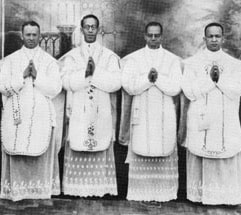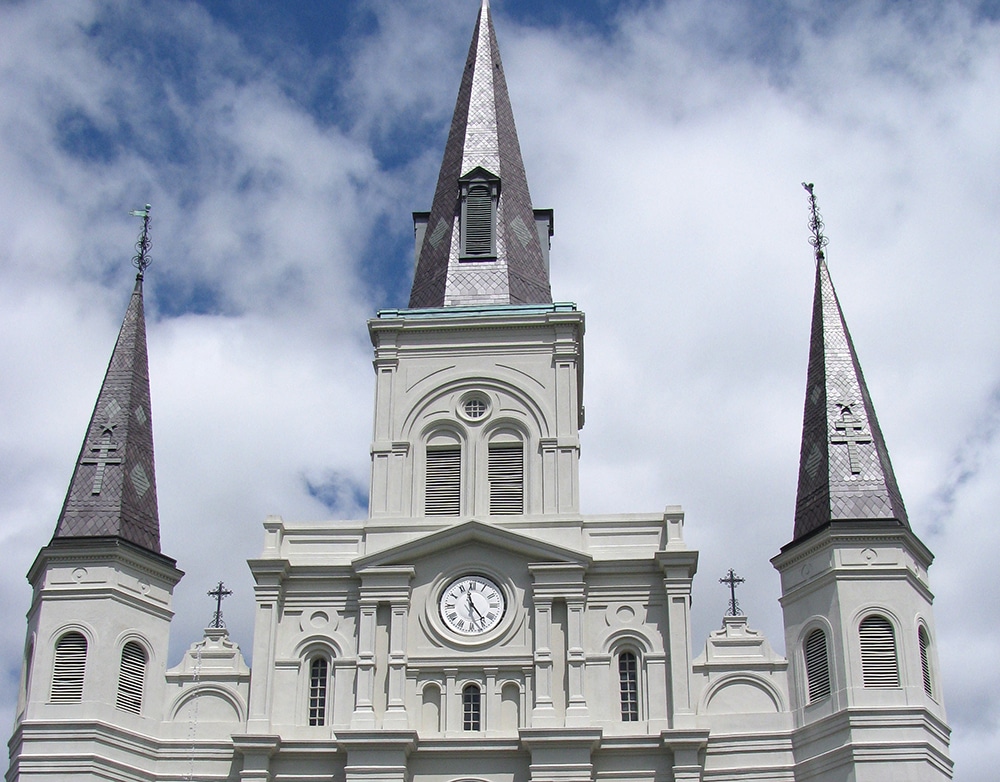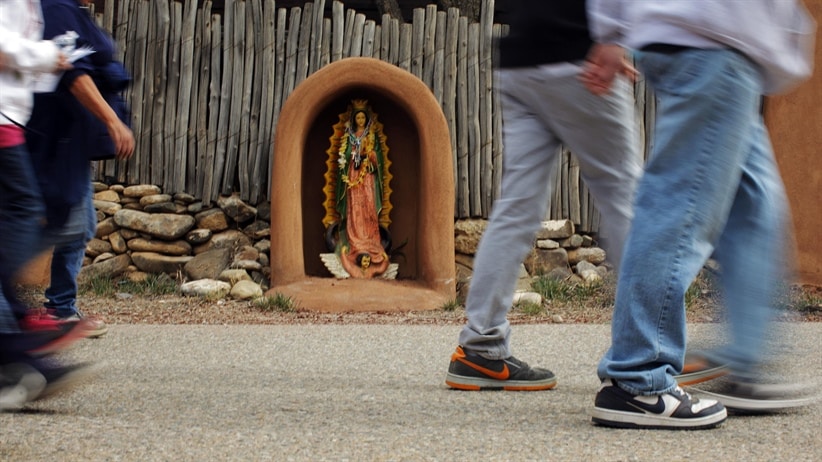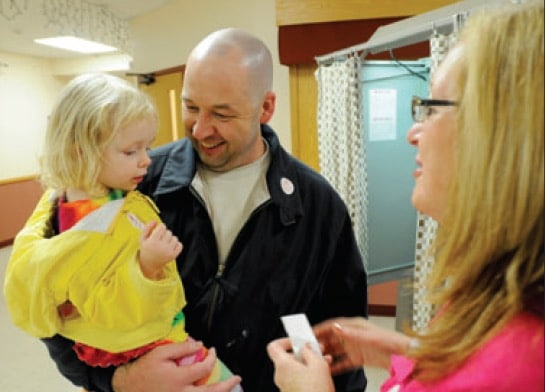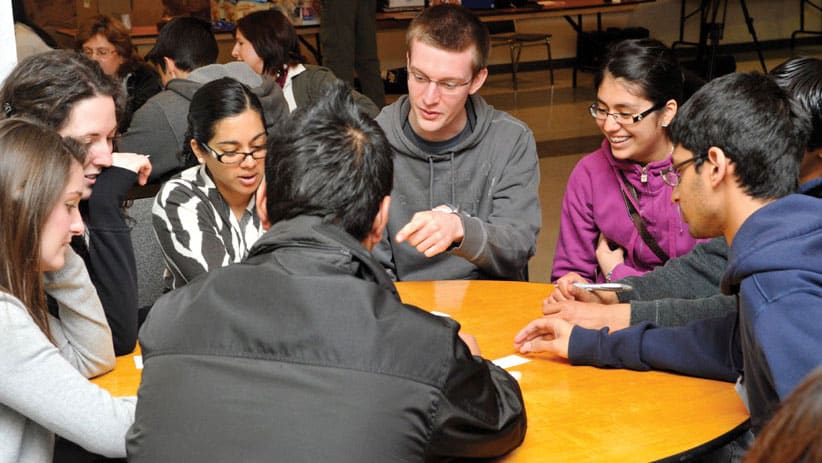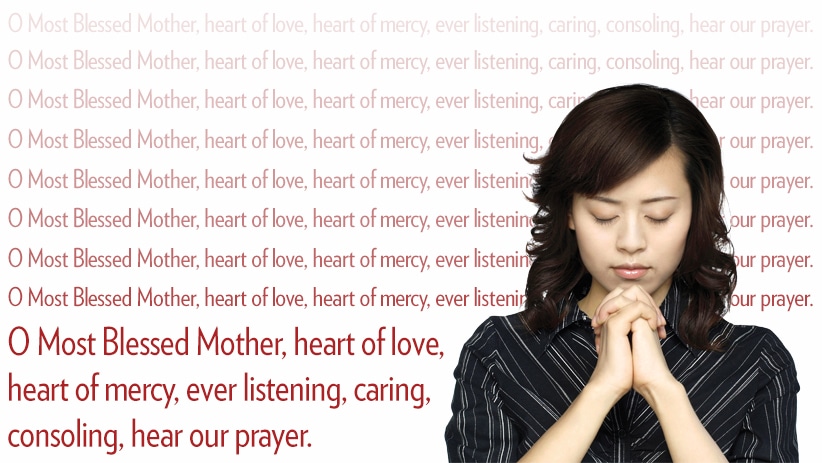Chicago history buffs will tell you that their city was founded in 1790 by a successful trapper and fur trader named Jean Baptiste Point du Sable. Less well known is du Sable’s background — he was black and Catholic.
Traditionally, most African Americans have been members of Protestant denominations, yet African-American Catholics have been a presence in this country since the earliest days of settlement, and they have played a fascinating part in the story of America and of the Church in the United States.
Longtime presence
In 1565, when Spanish colonists founded the city of St. Augustine in northern Florida, there were Africans among them — some free, others slaves. These Africans were Catholics, as the parish registers reveal. Spanish colonial society was not entirely colorblind, but it was more accepting of its black citizens than the English colonists to the north. Records show that black soldiers served in the St. Augustine garrison, and that black children were taught in the parish school alongside white children. In the 1700s, the Spanish authorities in Florida offered refuge to any slaves who escaped from the British colonies; if they accepted the Catholic faith, the runaways would be free. Records show that slaves from as far away as Maryland risked their lives to reach freedom in Florida.
There were free and enslaved blacks in the French colonies in Louisiana, along the Gulf Coast and up the Mississippi River, all of whom were Catholic. Creole society, a mixed-race blend of African and French culture, flourished in France’s American colonies, and Catholicism was an integral part of it. In the 1840s, Henriette DeLille of New Orleans founded a community of black and Creole sisters to serve the free black population of the city. Marie Couvent had been born in Africa, was taken as a slave to Louisiana where she won her freedom and married a successful businessman. At her death she left an endowment to establish a free school for free black and Creole orphans; the school was known as the Institute Catholique.
When Spanish colonists moved north into California, free and enslaved blacks were among the settlers. In 1781, 11 Catholic families founded the city of Los Angeles; half of those settlers were black.
On the other side of the country was Maryland. The colony had been founded as a refuge for Catholics, although by the end of the 17th century Catholics had lost political control of their colony. Nonetheless, the colony retained a strong Catholic subculture, and African slaves who were purchased by Catholics were taught the Catholic faith. In 1785, John Carroll, the first Catholic bishop of the United States, sent a report to Rome on the condition of the Church in America. Among other statistics, he reported that about 20 percent of Catholics in Maryland were black.
Slavery and the Church
Nonetheless, in 19th-century America, free black Catholics were victims of open hostility and discrimination from white Catholics and non-Catholics alike. In the 1820s in Baltimore, Mary Elizabeth Lange, a free black woman from Haiti, began teaching free black children in her home. In 1828, with the approval of her archbishop, James Whitfield, she founded a religious congregation for black women, the Oblate Sisters of Providence, dedicated to the education of black children. Although Mother Lange’s work won the approval of many American bishops and priests — St. John Neumann was a champion of the Oblate Sisters — many lay Catholics in Baltimore were outraged by the idea of black women wearing a religious habit.
In the decades leading up to the Civil War, the issue of slavery dominated national politics. In the South, some Catholics were slaveholders. Even bishops and religious communities owned slaves: the Jesuits, Capuchins, and Carmelite, Visitation, and Ursuline nuns all were slaveowners. So did Bishops John Carroll of Baltimore, Louis du Bourg of New Orleans, and Michael Portier of Mobile. At the other end of the spectrum stood Bishop John Baptist Purcell of Cincinnati, who called for the abolition of slavery.
In the first half of the 19th century an Irish immigrant, Michael Healy from County Roscommon, established a small plantation outside Macon, Ga. He fell in love with one of his slaves, Eliza Clark. As the law at the time did not permit interracial marriage, the couple lived as husband and wife in a common-law marriage that produced 10 children. Under Georgia law, the children were slaves, so one after another, Michael Healy sent his sons and daughters to schools in the North where they would be free. And he instructed his children not to return home to Georgia. Three of the brothers attended the newly opened College of the Holy Cross in Worcester, Mass.
The Healy family produced five religious vocations: James, Patrick and Sherwood all became priests. James joined the Sulpicians; in 1875 he was named bishop of Portland, Maine. Patrick joined the Jesuits; in 1866 he became president of Georgetown University. Sherwood was ordained a diocesan priest; he became rector of Holy Cross Cathedral in Boston, where a stained-glass window of St. Cecilia is dedicated to his memory.
Two of the Healy daughters became nuns. Josephine Healy joined the Religious Hospitallers of St. Joseph in Montreal. Eliza Healy joined the Congregation of Notre Dame in Montreal, and eventually was named superior of the Villa Barlow Convent in St. Albans, Vt.
The Healy family’s accomplishments should entitle them to an impressive series of “firsts” — first African-American bishop, university president, mother superior. But the Healys self-identified as white, and for the most part they were accepted as such.
The man considered the first African-American priest is Father Augustus Tolton. His parents were Catholic slaves in Missouri. During the Civil War, Tolton and his mother, brother and sister escaped across the Mississippi River to Illinois. They settled in Quincy, where there was a community of escaped slaves and a black Catholic church, St. Joseph’s. Tolton wanted to become a priest, but no American seminary would accept a black candidate. He traveled to Rome, where his race did not matter; he was ordained in 1886 and returned to the United States. He was assigned to St. Joseph’s in Quincy.
Father Tolton’s dynamic sermons attracted white Catholics to his church, many of whom gave generously. The pastor of one of the white parishes in Quincy — who always used a hateful epithet when referring to Father Tolton — complained to the bishop that his parish’s finances were being undercut by Father Tolton’s interracial ministry. The bishop ordered Father Tolton to minister only to black Catholics. Father Tolton was stung. He had encountered discrimination before, but never from a brother priest, and never from a religious superior.
To escape the harassment, Father Tolton wrote to the Congregation for the Propagation of the Faith in Rome and asked to be reassigned to Chicago. He received his new assignment in 1889. In Chicago, Father Tolton was responsible for all black Catholics in the city. At the time of Father Tolton’s arrival they worshipped in the basement of St. Mary’s Church. Tolton moved them into a storefront that he converted into a chapel. His parishioners were too poor to build a church, so Father Tolton solicited funds from Catholics throughout the Chicago area. In 1894 the new church, dedicated to St. Monica, was consecrated. It became the mother church of the black Catholic community in Chicago.
Lay leadership
The Civil War brought about the emancipation of 4 million black slaves. Archbishop Martin Spalding of Baltimore saw this as an opportunity and urged his brother bishops to begin an aggressive program of evangelization that he hoped would reap “a harvest of souls.” An English missionary order, the Mill Hill Fathers, began the work in 1871. In 1892 the congregation in America renamed itself the Society of St. Joseph of the Sacred Heart, or the Josephites. The Society of the Divine Word also evangelized African Americans, especially in the South.
Joining the missionary fathers was a new American congregation, the Sisters of the Blessed Sacrament. Beginning in 1890, Philadelphia banking heiress, St. Katherine Drexel, devoted her fortune to opening schools for African-American and Native American children. During the 1930s, Mother Drexel also contributed to the NAACP and to organizations that fought lynching. And in New Orleans she founded Xavier University, the only black Catholic university in the United States.
The efforts of these missionary priests and sister brought black converts into the Church, but that is only part of the story. Sadly, racism was so entrenched in American society, including within the Catholic Church, that no seminary in the United States would accept black candidates for the priesthood. Black men who were called to the priesthood followed the example of Father Tolton and left the country to study and be ordained in Europe. As a result, almost every black parish in 19th-century America was led by a white priest.
Leadership in the black Catholic community fell to the laity. Daniel Rudd, a former slave from Kentucky, founded the National Black Catholic Congress in 1889. Rudd believed that in post-Civil War America the Church could help African Americans enter mainstream society. At his invitation, 85 black Catholic laymen assembled at St. Augustine’s Church in Washington, D.C., to discuss ways to strengthen the unity of black Catholics and bring more African Americans to the faith. At the same time, they held candid discussions about the difficulties they encountered as a result of racism in American society and within the Church. Among the guest speakers at this first Congress were Father Tolton and Cardinal James Gibbons of Baltimore. And President Grover Cleveland hosted a reception for the delegates at the White House. Rudd would organize five such congresses, which laid the groundwork for lay leadership among black Catholics.
Rudd’s colleague was Thomas Wyatt Turner, a biology professor at the historically black Howard University. Turner openly challenged the racist policies of the Church in the United States by calling for the ordination of black men to the priesthood and an end to regulations that barred black Catholic children from admission to Catholic schools.
In the 1950s, when the civil rights era began, there were approximately 400,000 black Catholics in the United States, and about 100 black Catholic priests. The leaders of the movement were black Protestant ministers — Dr. Martin Luther King Jr., Rev. Ralph Abernathy, Rev. Jesse Jackson — but black Catholics and white Catholics, including priests and bishops in their clerical suits and nuns in their habits, were conspicuous at civil rights marches and demonstrations.
The social and religious ferment of the 1960s led to the founding of new associations for black Catholics: the National Black Catholic Clergy Caucus, the National Black Sister Conference, as well as support organizations for black seminarians and black laity. In African-American parishes the art, symbols, and vestments often reflected African models. Music, movement, and preaching were transformed as parishes adopted the worship style of evangelical black churches. In the 1980s Father George Stallings of Washington, D.C., sought the permission of his archbishop to found an African American rite parish with a distinctive African liturgy. The archbishop denied the request, so Father Stallings left the Catholic Church and founded his own congregation, the Imani Temple, as the mother church of his African American rite.
American bishops addressed the issue of racism inside and outside the Church in 1979, in a pastoral letter, “Brothers and Sisters to Us,” which denounced racism as sinful.
In “Brothers and Sisters to Us,” the U.S. bishops addressed both black and white Catholics, lamenting the sins of the past, and resolving to build a better future. “Here must be no turning back along the road of justice,” the bishops wrote, “no sighing for bygone times of privilege, no nostalgia for simple solutions from another age. For we are children of the age to come, when the first shall be last and the last shall be first, when blessed are they who serve Christ the Lord in all his brothers and sisters, especially those who are poor and suffer injustice.”
Thomas J. Craughwell is the author of “Stealing Lincoln’s Body” (Harvard University Press, $24.95) and “Patron Saints” (Our Sunday Visitor, $14.95).
African-American Converts to Catholicism
Mary Lou Williams: Mary Lou Williams was a musical prodigy, who at age 6 was playing the piano professionally. From the 1920s through the 1940s, she played with a variety of swing and jazz bands. She also composed music, including “In the Land of Oo-Bla-Dee” for Dizzy Gillespie’s band. In 1954, Williams’ heart turned toward spiritual matters. Near her apartment in Harlem was the Church of Our Lady of Lourdes; Williams went there often to pray in the lower chapel. She decided to take instruction in the Catholic faith, and was baptized in 1956. She continued to write and arrange and perform jazz, but she also wrote liturgical pieces, including a jazz-inspired Mass for the Lenten Season, and a cantata based on the life of St. Martin de Porres, “Black Christ of the Andes.” At her death in 1981, Dizzy Gillespie performed at her funeral Mass.
Sister Thea Bowman: Thea Bowman was raised a Methodist in Yazoo City, Miss., but at age 9 she asked her parents if she could convert to Catholicism. Her parents gave their consent. In 1954 Bowman entered the novitiate of the Franciscan Sisters of Perpetual Adoration. She taught at elementary and high schools, as well as at Catholic University in Washington, D.C., and Xavier University in New Orleans. After 16 years in the classroom, the bishop of Jackson, Miss., invited Sister Thea to be his consultant on intercultural awareness. Her dynamic approach — which used songs, storytelling, and gospel-style preaching — attracted large audiences, and soon she was traveling across the United States, delivering 100 presentations a year. In an interview with Mike Wallace on “60 Minutes,” Sister Thea said, “I think the difference between me and some people is that I’m content to do my little bit.” Sister Thea died of cancer in 1990 at age 52.
Alex Jones: In the 1990s, Alex Jones, pastor of a small African-American Pentecostal congregation in Detroit, began reading the Fathers of the Church and studying the origins of Christianity. His studies convinced him that the doctrines and liturgy of the early Church were fully preserved only in the Catholic Church. He began discussing his conclusions with his congregation. Then he called Steve Ray, an evangelical Protestant who had converted to Catholicism. His ongoing studies and his regular conversations with Ray led Pastor Jones to make the decision to accept the Catholic faith. Fifty-six members of his congregation joined him. They entered the Church at Easter, 2001.
African Saints and Popes
Pope St. Victor I (reigned c. 186-201): St. Victor was born in Leptis Magna in what is now Libya. While Greek had become the fashionable language in Rome, in North Africa Latin was still spoken. When he was elected pope, Victor always celebrated Mass in Latin. (Perhaps he was not very fluent in Greek). Feast day: July 28.
Pope St. Miltiades (reigned 311-314): A member of the Berber people of North Africa, Miltiades witnessed the liberation of the Church by Emperor Constantine. The laws that had outlawed Christianity and created countless martyrs were abolished, and Christians were free to practice their religion in public. As a sign of his favor, Constantine donated to Pope Miltiades the Lateran Palace, which became the residence of the popes. Feast day: Dec. 10.
Pope St. Gelasius I (died 496): A Roman priest of African descent, Gelasius was elected pope in 492. At a time when the emperor in Constantinople claimed authority over the Church, Gelasius championed the independence of the Church and asserted the spiritual authority of the popes over all Christians. Feast day: Nov. 21.
St. Anthony of the Desert (251-356): Anthony, the son of well-to-do Egyptian Christians, lost both his parents by the time he was 18. He sold his estate and gave all the proceeds to the needy, then traveled into the desert where he lived as a hermit, spending long hours in prayer, meditation and studying the Bible. His reputation for holiness attracted disciples, and for them he founded near the Red Sea the first monastery in the Christian world. Feast day: Jan. 17.
St. Monica (331-387) and St. Augustine (354-430): The daughter of a distinguished Christian family, Monica was a Berber who grew up in what is now Algeria. Her son, Augustine, did not share her religious devotion, and broke her heart by keeping a mistress, fathering an illegitimate son and joining the heretical Manichean sect. For 17 years Monica prayed for her son’s conversion, and at last her prayers were answered. Augustine was baptized, ordained a priest, and eventually named bishop of Hippo in North Africa.A man of tremendous intellect and profound spiritual insight, Augustine is the most influential theologian in the history of the Church, second only to St. Paul. Feast days: Aug. 27 and Aug. 28.
St. Charles Lwanga and the Martyrs of Uganda: In 1885 Mwanga, king of Uganda, developed an intense hatred of European missionaries and their African converts. In his court were nearly two dozen Catholic converts, and these became his easiest targets. A servant, Charles Lwanga, 21, acted as spokesman for the Ugandan Catholics. Mwanga had 22 of them burned alive. The youngest of the Ugandan martyrs was St. Kizito, a 14-year-old page boy. Feast day: June 3.
St. Josephine Bakhita (1868-1947): Nine-year-old Bakhita was playing in the fields near her parents home in Sudan when she was kidnapped by slave traders. She was sold three times before she was 15; then Italy’s consul to the Sudan purchased her so he could free her. When the consul and his family returned to Italy, Bakhita accompanied them. In Italy she converted to Catholicism and joined the Canossian Sisters in Venice. She became her convent’s spokeswoman, traveling from parish to parish appealing for funds for the African missions. Feast day: Feb. 8
Black Candidates for Sainthood
Venerable Pierre Toussaint (1766-1853): The Berard family, who owned Pierre Toussaint, took him with them when they emigrated from Haiti to New York. The Berards apprenticed him to a hairdresser; soon, Toussaint was the most popular hairstylist in the city. In 1807 Madame Berard died, and in her will she freed Toussaint. From his savings he purchased the freedom of Juliette Noel, who became his wife. The couple was dedicated to good works: they sheltered orphans in their home, helped the poor, especially poor blacks, and even found work for the unemployed. Toussaint began every day with Mass at St. Peter’s Church, the parish where Mother Elizabeth Ann Seton had converted. For more information: Pierre Toussaint Guild, 1011 First Ave., New York, NY 10022.
Mother Mary Lange (c.1784-1882): Mother Lange’s parents were well-to-do free blacks in Haiti. To escape political unrest at home, Mother Lange emigrated to the United States, settling in Baltimore, where there was a large community of Haitians. In her home she opened a school for free black children, a project which led to the founding of the Oblate Sisters of Providence, the first religious order for African-American Catholic women. In spite of poverty and racism, Mother Lange and her sisters expanded their apostolate to include nursing the sick and sheltering the elderly. For more information: www.motherlange.org/
Venerable Henriette Delille (1812-1862): The daughter of a well-to-do white man and his free black mistress, Henriette chose a life of chastity and dedicated herself to serving the poor free blacks of New Orleans. In 1842 she founded the Sisters of the Holy Family to nurse the sick, shelter orphans, and educate black and mixed-race children. For more information: www.sistersoftheholyfamily.com/
Augustus Tolton (1854-1897): Born into a family of slaves in Missouri, Augustus Tolton became free in 1862 when his mother took him, his older brother, and his younger sister across the Mississippi River to Illinois. In 1886, he became the first African American ordained a Catholic priest. Father Tolton was assigned first to his hometown, Quincy, Ill., then to Chicago, where he founded St. Monica’s parish on the South Side. For more information: www.toltoncanonization.org/

